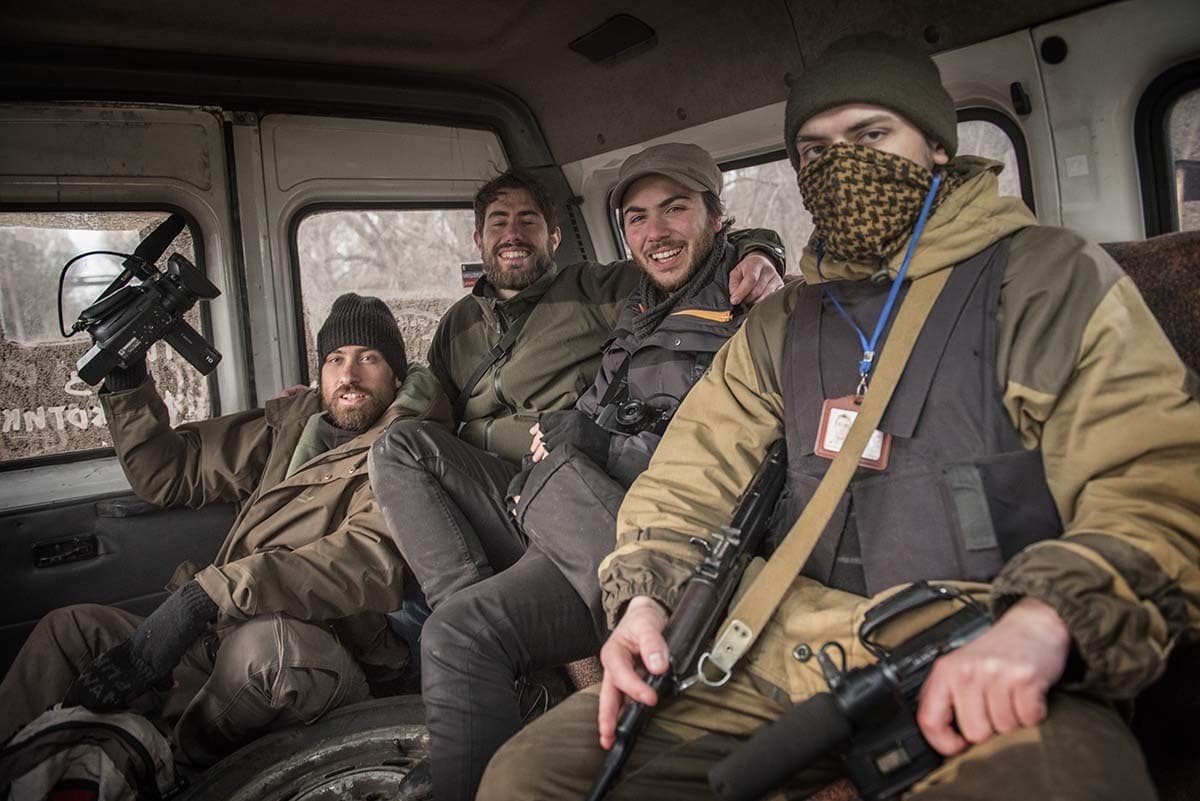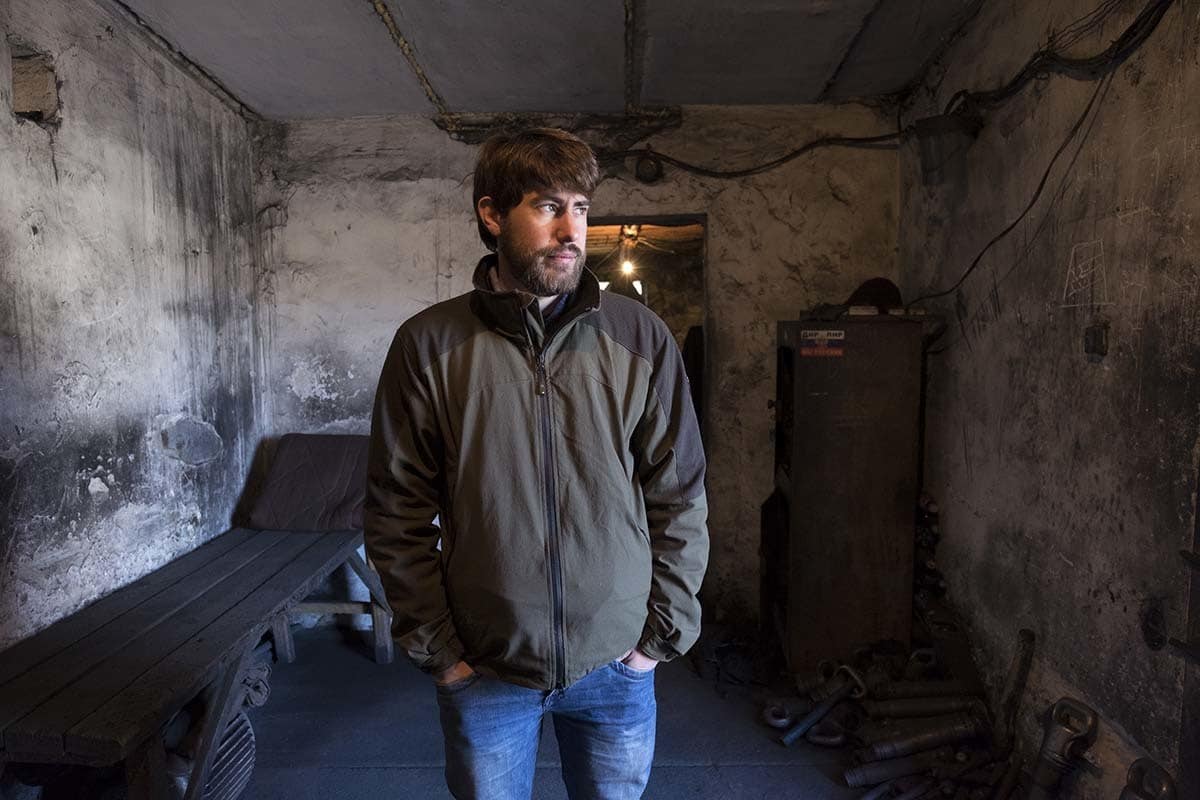When speaking to Italian author, journalist, and documentarian Andrea Sceresini, one immediately gets the feeling that the concepts of danger, risk, and reward have different definitions on the other side of the table.
For a reporter who has filmed, written, and produced reportages from some of the world’s most dangerous conflict zones, Sceresini seems utterly relaxed. Sitting outside of the Cascina Martesana on a cool spring evening in Milan, he tells tales of detainment, shelling, and the casual art of survival while working abroad.
His nonchalance permeates through his account of being arrested in Ukraine. Sceresini was caught shooting footage in the off-limits zone of the contested Donbass region by the operating (if unofficial) separatist government. “We spent the night in prison and we were let go on the following day,” Sceresini says. “Not a big deal, these things happen.”
One year prior, in 2015, under the impression that Sceresini and his colleagues had entered the country illegally through the deregulated border with Russia, the Ukrainian authorities banned him from entering the country for five years.
But that experience came after years of becoming accustomed to similarly intense situations. In the past, Sceresini has reported from areas of civil unrest in Egypt, Hungary, and Caracas, Venezuela.
While violence and corruption garner the most attention in Sceresini’s work, he remains focused on discovering stories, not thrills. “I don’t use a fixer,” he says, smoking a cigarette that’s become the trademark of his book inlays. “I don t want to be brought to places by somebody that works for the propaganda or the government.”
For Sceresini, staying in upscale hotels with private security is a hindrance to the honest truth he’s looking for. “That seems more like tourism to me,” he says. “[Other journalists] all interview the same people and see the same things.”
Instead, Sceresini and his colleagues, which typically include a photographer and another journalist, organize everything themselves. They research and extract the contacts they can and then try to integrate themselves in the local social fabric. “It is critical for me to report from very close to the place where things happen, as real and live as it can be,” says Sceresini. His work is inherently molded by the circumstances it’s conceived in. For Sceresini, the substance remains more important than the style. “My job is telling stories from forgotten places, where forgotten and suffering people are the protagonists,” he says. “Human lives do not have the same value—you are face to face with death every day.” While fear tries its best to grip, Sceresini remains invested in the value of his work. He’s a reporter, he says, “I can’t help it.”

Sceresini and his crew in Donbass, Ukraine.
It’s easy for Sceresini to stomach the risks involved in his work because he trusts in its relevance. But his nonchalant nature seems more a consequence of his experiences than its catalyst. Sceresini sometimes finds it difficult to readjust to the everyday after spending time in a conflict zone.
“It’s nice going back home where things are safe,” he says. “At the same time, you develop an addiction to danger and adrenaline.” The result of that altered perspective is difficult to ignore. And dealing with trends in mainstream media can be frustrating. “I go where heavy, dramatic things happen,” Sceresini says. “When you return, you notice how superficial the things our media talk about are sometimes.” This disparity in journalistic perspective is part of what drives Sceresini to organize his own coverage, even when many Western media outlets feel it doesn’t warrant the attention.
Sceresini visited the Donbass region in Ukraine for the first time in 2014. He’s visited three more times since. But none of these visits have retained the media presence that the region saw at the outbreak of the conflict. The war was at its peak in 2014. “There were bombings everywhere, even in the city center of Donetsk,” he recalls. “It is a city of one-and-a-half million people, and the majority of the population had left.” In between hours of waiting for news that it was safe to visit the front lines, Sceresini would sit around in a flat with his colleagues, listening to bombing just hundreds of metres away.
As the situation calmed in Ukraine, so did the media presence. But Sceresini continued to return, in order to document the stories and subjects that would have otherwise remained unreported. He recalls the visit he made to the frontlines of the Ukrainian separatist camp. Attentive to active landmines and the official Ukrainian military on the opposite side, Sceresini was able to get unfiltered footage and an accurate, first-hand account of the war.
The trenches were off limits, and Sceresini needed official clearance from the Russian separatist government to gain permission. Piecing together a few Russian words, he was taken to the town sheriff or mayor—his role was never confirmed. “He had a gun on his desk, he was playing with it and he was a little drunk,” Sceresini tells Format Magazine. “The situation would have been grotesque, if it was not scary.” After a brief chat in broken Russian, he was granted permission to visit the site.
Sceresini was brought to the camp and picked up by the same figure two days later. It proved monumental in his understanding of the conflict. “I talked to the soldiers, spent time side by side with them, I ate their food, I talked about their lives and families,” he says. “I tried to share their feelings—that’s the kind of reporting I love to do.” Although stories abound in areas of civil unrest, working conditions can become difficult and dangerous quickly. Adaptability is a crucial skill. Belief in his work is fundamental, although it’s so ingrained in Sceresini that it’s not always something he’s conscious of.
“You have to push it to the limits and go a little beyond,” he says. “It’s the only way I can and want to do this job.” What he sacrifices in style choices, he compensates for in restricted footage. Along with his Canon XA30 video camera, he gets up close and intimate with his sources and subjects. It’s an attitude he continues to try to employ, even in his current work for national Italian media outlet RaiTV.
For the most part, Sceresini’s attention still remains on the situation outside of Italy. “According to rumors, the Ukrainian army is organizing a counterattack to regain control of the Donbass [region],” he speculates. It remains to be seen whether the offensive will actually materialize. “I’ll be there if they attack,” he says. “For sure.”
With translation by Davide Soncin. Cover image: Sceresini in Donbass. Images via Andrea Sceresini.
More on photojournalism:
Photojournalist Emily Garthwaite Sees Photography as Therapy
Inside Andrew Harnik’s High Stakes World of Political Photojournalism
How to Become A Professional Photojournalist












